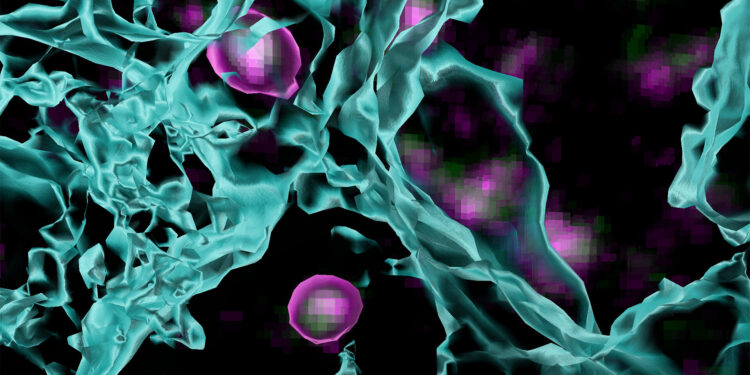Oligodendrocyte precursor cells, or OPCs (the purple and green spots above), prune unnecessary synapses (the silver streaks) in the brain’s visual cortex in response to new information and experiences. Credit: Cheadle Laboratory/Cold Spring Harbor Laboratory
Imagine yourself in the distant future aboard a routine rocket to Mars. Someone just spilled their drink. Without gravity, it accumulates in floating drops that undulate before your eyes. Now freeze.
What you see might look like the image above from Cold Spring Harbor Laboratory’s (CSHL) Cheadle Lab. But those purple and green blobs aren’t the floating remains of someone’s drink. These are mysterious cells in the brain’s visual cortex, called oligodendrocyte precursor cells (OPCs). The results are published in the journal Natural protocols.
The visual cortex processes everything we see. Incoming visual information is relayed to this outer layer of the brain via synapses – the silver streaks above. When the brain’s neural circuits are first connected, more connections, or synapses, are created than necessary. As the brain accumulates new experiences and information, OPCs shape neural circuits by eliminating unnecessary synapses.
“OPCs do all kinds of things in the brain that help it function in a normal, healthy way,” says Lucas Cheadle, an assistant professor at CSHL. OPCs are a specialty of the Cheadle laboratory. He and his team discovered the function of OPCs as neuronal landscapers in 2022. Before that, they were thought to produce only oligodendrocytes, cells that sheath and support neurons. Today, Cheadle has developed new ways to zoom in and see mutual funds in action.
“We are able to see what thousands of TPOs, and even smaller groups of 30 to 50 people, are doing,” he explains. “From there, we can determine which synapses are fully engulfed by an OPC, which are in the process of being pruned, and which may have just been checked by an OPC but not processed.”
The new techniques used to produce the image above have become essential tools in Cheadle’s current work. He and his team are now building on their 2022 discovery to help build a comprehensive picture of the role of OPCs in health and disease.
Cheadle explains: “These mysterious cells are one of the main sources of glioma,” a deadly brain cancer. “They are also potentially involved in Alzheimer’s disease.”
More research is needed to illustrate these connections in detail. In the meantime, Cheadle is eager to share his lab’s new tools with researchers around the world.
“The brain is constantly evolving, and the same approaches you would use to look at one cell type cannot be applied across the board,” he says. “We are adapting and innovating to keep pace, to better understand how the brain works.”
More information:
Jessica A. Kahng et al, High-confidence, high-throughput quantification of synapse engulfment by oligodendrocyte precursor cells, Natural protocols (2024). DOI: 10.1038/s41596-024-01048-1
Provided by Cold Spring Harbor Laboratory
Quote: New techniques shed light on how brain landscapers prune unnecessary synapses (2024, October 10) retrieved October 10, 2024 from
This document is subject to copyright. Except for fair use for private study or research purposes, no part may be reproduced without written permission. The content is provided for informational purposes only.



